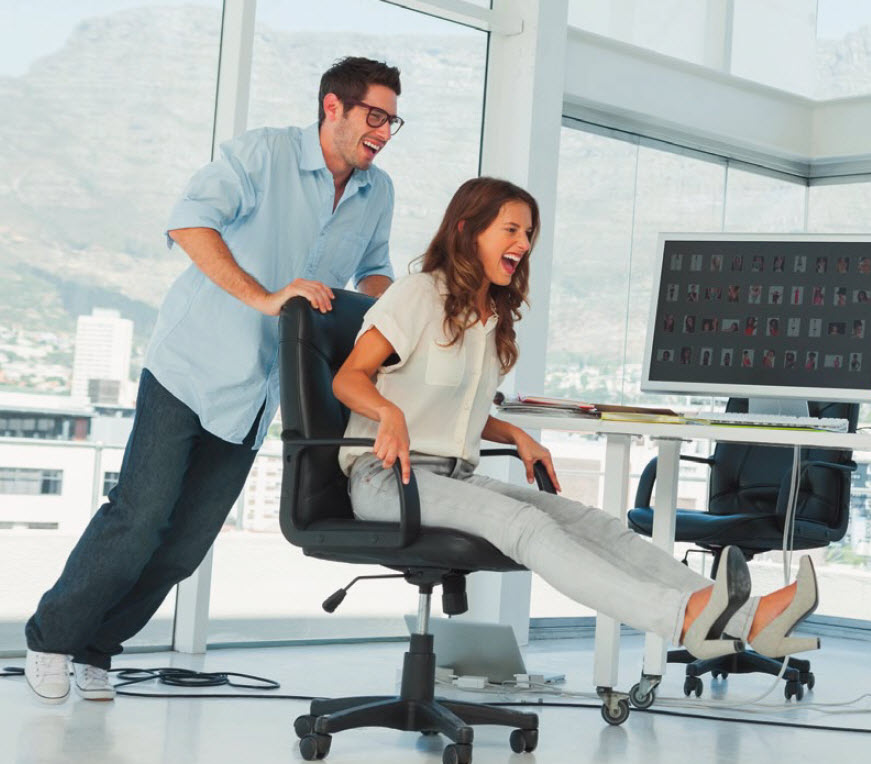20 years of research on work management and organization
The Fraunhofer Institute for Industrial Engineering (IAO) is celebrating its birthday. Since 1996, the institute has been driving the Office 21 collaborative research project together with partners from industry. The central question has always been: What does the future of our working world look like? In order to make these developments not only scientifically comprehensible, but also actually tangible, the information and demonstration center "Office Innovation Center" was founded.

In their current study 'Digital Working. Motives and effects of paperless working methods', the IAO researchers focus on a new topic of the future, the paperless office.
"For the first time, we have not only created a demonstration center for presenting new concepts and products on the subject of office design, but also a playground for evaluating the suitability of innovative office solutions in detail and developing them further," says Professor Wilhelm Bauer, initiator of the project and head of the IAO in Stuttgart. Since its beginnings, the IAO has been trying to keep its finger on the pulse and think up work scenarios of the future.
Here is an overview of milestones from 20 years of ILO research:
2000: From the industrial society to the knowledge age
The time of the industrial society is over - we are on the way to the knowledge age. With this forecast, Office 21's first research paper lays the foundation for the path into the digital era. In their publication 'Shaping office work in the dotcom society', authors Hans-Jörg Bullinger, Wilhelm Bauer, Peter Kern and Stephan Zinser diagnose a turnaround in the world of work. Coal and steel are a thing of the past; the raw materials of the future are now called knowledge and information. Creativity is replacing the assembly line as a productivity factor.
This also transforms employees from isolated units into "knowledge workers" who move like nomads in networks.
2003: The employee as the most important resource
The human factor is moving to the center of the working world. This is the second major forecast made by the ILO. More Performance in Innovative Working Environments' is the title of the handbook with which the institute is primarily addressing companies. Here, they will find practical aids and tried-and-tested practices for motivating employees in companies. Behind this is the realization that people have become the most important resource in companies.
The motivation, knowledge and creativity of employees alone determine the success and productivity of the company. This also means that the needs of employees must be taken seriously. A nice company car is no longer enough of a reward. Employees demand more flexibility, more creative freedom and more freedom to make decisions on the job.
"Change Management" is the magic word that Office 21 wants to push in its second major publication. Triggered by new office forms, by groundbreaking advances in information and communications technology, and by the knowledge of the "success factor" people, companies must rethink. Those who want to be successful in the working world of the future must therefore focus on the "feel-good factor people".
2010: Offices go green
Companies want to create sustainable jobs. In another milestone of their office research, the ILO scientists state: "There is still enormous potential for exploitation to increase ecological sustainability in companies and in office work." In their 'Green Office' study, the researchers asked German companies about their ideas on sustainable workspaces. In the study, 42 percent of the companies surveyed answered that environmentally friendly and resource-saving technologies were very important to them.
This shows a change from purely profit-oriented to ecologically committed companies. The place of work is thus also becoming a social place. Employees and also customers no longer care where they work and what products they buy. Conscious consumers and employees want to know exactly what social contribution a company is making. This often decides whether they buy a product or work for a company.
We identify more with our work and therefore demand more commitment from companies. The forecast for the workplace of the future in 2010 was therefore socially engaged and ecological.
2012: Visionary working worlds
What will our future look like in ten years? This is the question that researchers at Office 21 are exploring in their study 'Working Worlds 4.0 - How we will work and live tomorrow'. The clear vision: Our world is becoming more digital. This not only affects our work, but also our digital selves. Our appearance on the web is our future business card. The researchers speak of a "digital aura.
Another prediction is the dominance of cloud technologies. Our mobile technologies supply themselves with information. Depending on where we are and who we are, we are constantly supplied with information that is relevant to us. Even if this is a little too reminiscent of "Minority Report" for some, the researchers talk optimistically about how everything will run "seamlessly and wirelessly".
Furthermore, the scientists predict that older employees will continue to be active - especially in their professional lives. Accordingly, their know-how is considered an important resource for companies. The workplace is also changing: In ten years, we will no longer have stiff open-plan offices; our desks will be dynamic, work-friendly and individually tailored to each employee. Welcome to the working world of the future!
2014: The office becomes a coworking space
After Office 21's research took a very close look at the development of office space, the researchers have identified a completely new trend: away from the classic desk and toward collaborative working in a coworking space. In their publication 'Fascination Coworking', the researchers go into detail about the successful coworking model.
It is precisely the openness of such workspaces and the loose organization that is attracting more and more companies and freelancers to shared offices. This seems to reflect the trend toward more room for development. Employees can organize their working hours more individually and exchange ideas with colleagues much more dynamically. But that's not all - it's the exchange with coworkers from outside the industry that seems to steer creativity in completely new directions.
New business concepts and unimagined collaborations emerge. The coworking space thus becomes the creative tinkering room of the working world.
2016: The farewell to paper
In their current study 'Digital Working. Motives and effects of paperless working methods', the IAO researchers focus on a new topic of the future, the paperless office. Particular attention is paid to the relationship between digital or paper-based working and personal performance. In other words, are we more successful if we write everything down on paper with a pen and print out documents, or do we work more productively if our notes and information remain digital? With this topic, Office 21 is once again on the trail of a trend.
The trend toward a knowledge society, the digitization of our world and the development of new forms of work are just some of the new trends that will restructure the world of work. The IAO's research is and will continue to be an exciting barometer of the current and future world of work.


















